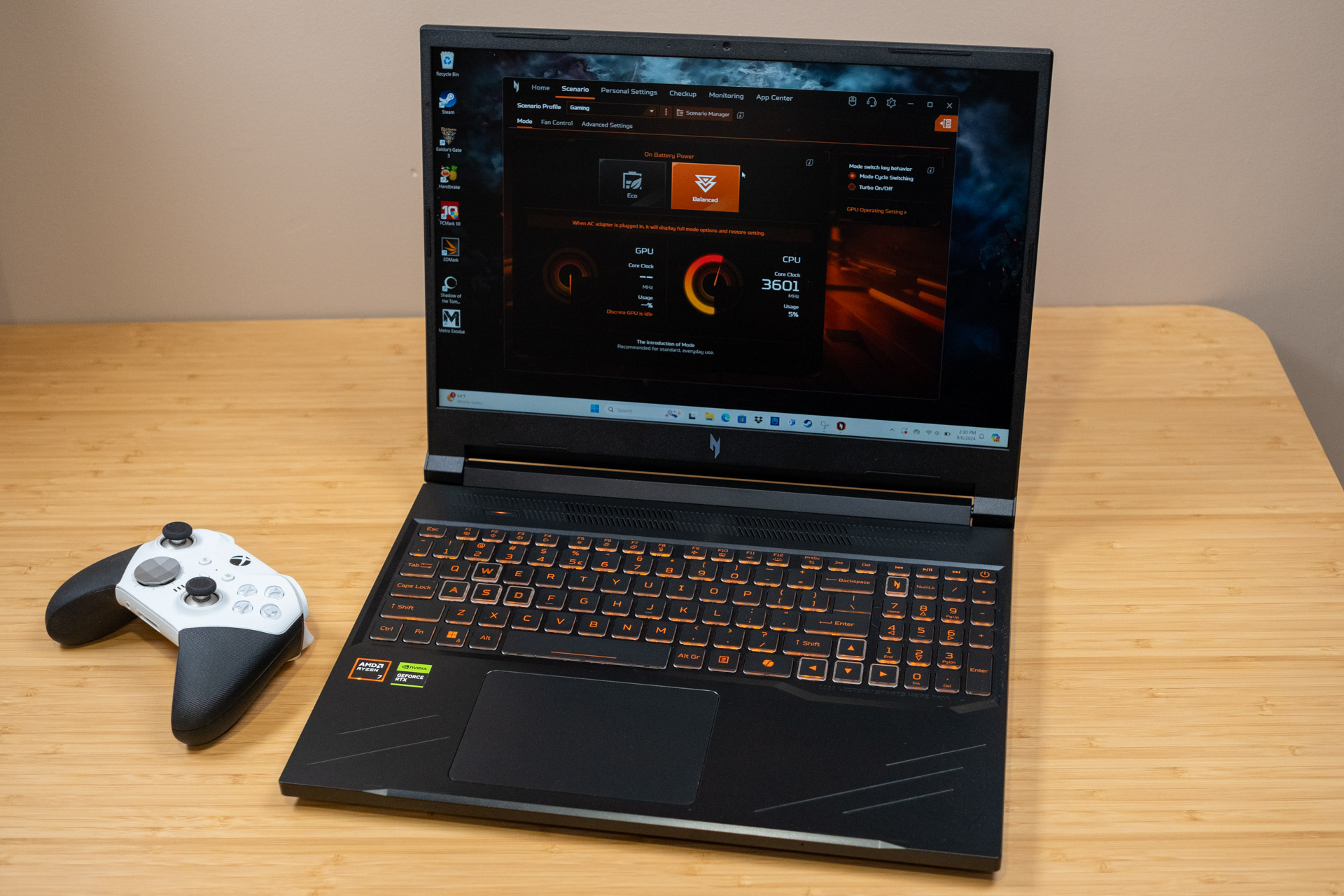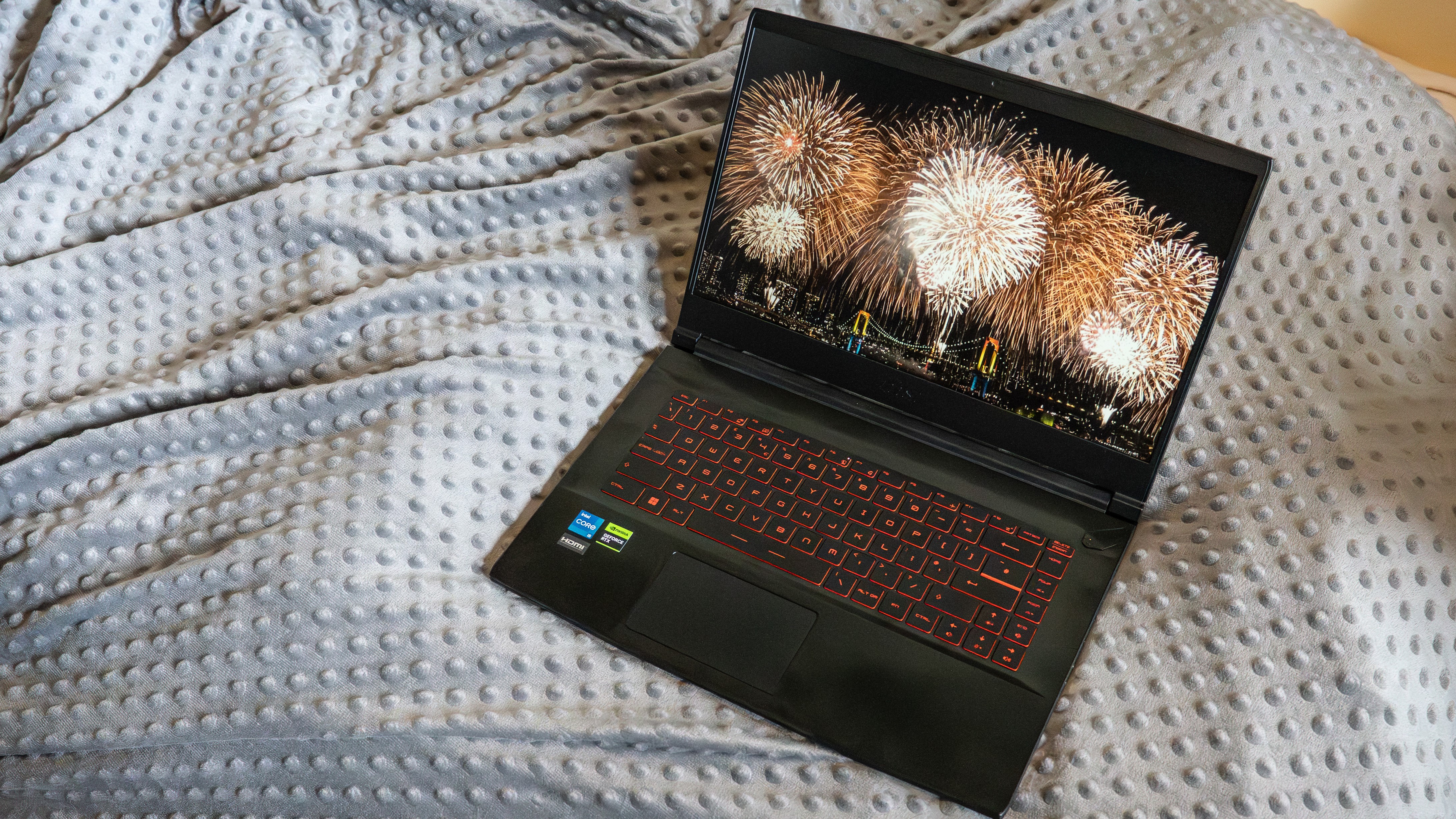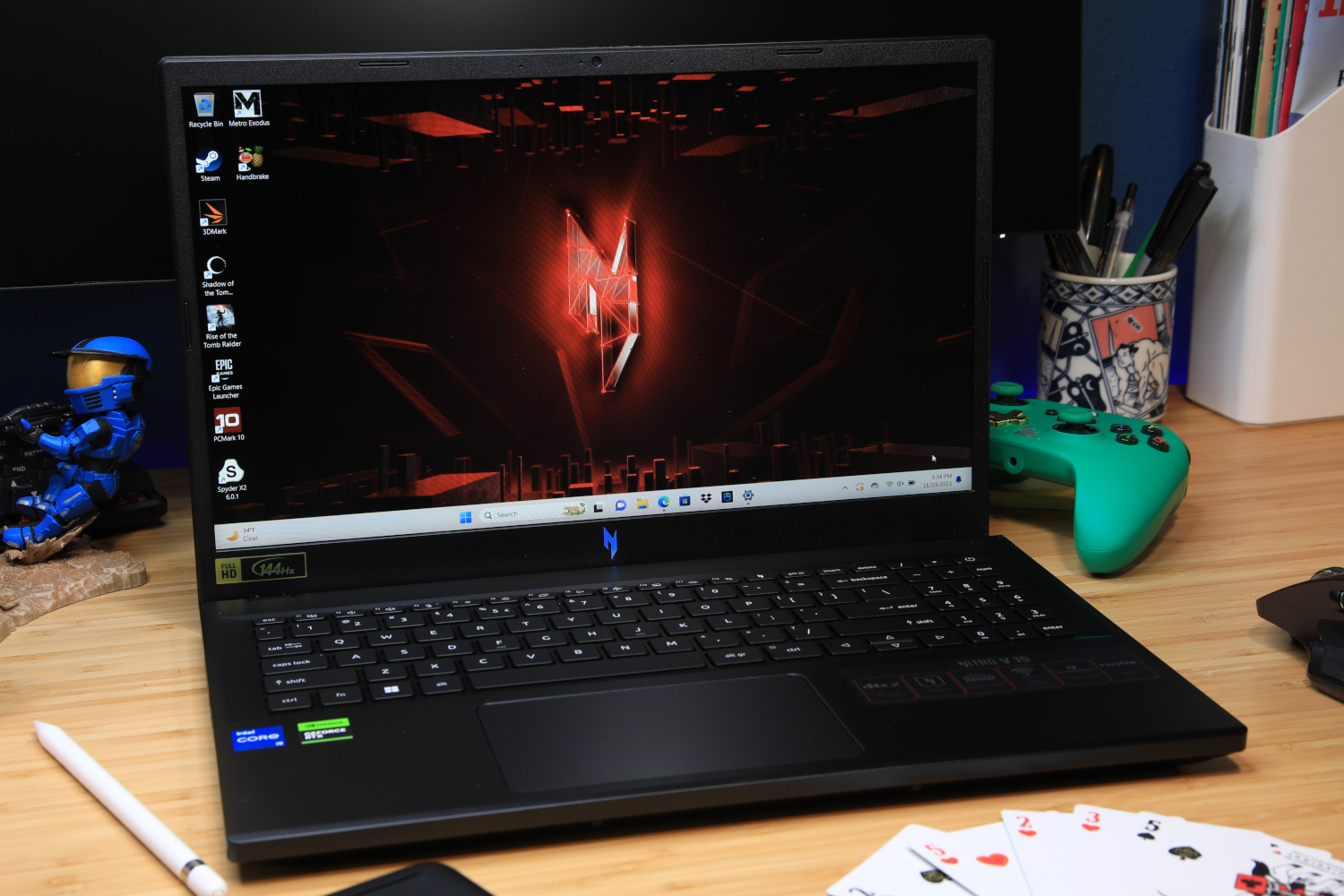Best gaming laptops under $1,000: Expert picks that won’t break the bank
If you’re a PC gamer, you know how expensive it can be. In addition to purchasing your favorite triple-A titles, you also need a powerful machine to run them on. When it comes to gaming laptops, it gets even more complicated, as it requires an intricate cooling system to handle the heat-generating components inside. Fortunately for you, there are some inexpensive options out there. In fact, when it comes to a sub-$1,000 gaming laptop, you don’t have to cut as many corners as you may think.
If you’re feeling totally lost, don’t worry–we did the hard work for you. The laptops below have been personally tested and vetted by members of the PCWorld team, so you know you’re getting a good machine. Just note that laptop prices can fluctuate, so our picks below may occasionally go over $1,000. For more recommendations on gaming laptops, see our roundup of the best gaming laptops across all prices, or take a look at our roundup of the best laptop deals.
Why you should trust us: Hey, it’s in our name! PCWorld prides itself on laptop experience and expertise. We’ve been covering PCs since 1983, and we now review more than 70 laptops every year. All of the picks below have been personally tested and vetted by our experts, who’ve applied not only performance benchmarks but rigorous usability standards. We’re also committed to reviewing PC laptops at every price point to help you find a machine that matches your budget.
Updated September 19, 2024: We have a new Best Overall recommendation: the Acer Nitro V 16 ($1,099.99), which gives you a big display with a high refresh rate (perfect for action games!) and a RTX 4060 GPU that will let you run most games on the Medium or High graphics preset. We’ve also updated our list of recent laptop reviews, so be sure to check those out near the bottom of the page.
Acer Nitro V 16 – Best overall


Pros
- Solid performance
- Competitive price
- Dedicated button for quick performance mode switching
- Fast 165Hz display with good colors
Cons
- Fully plastic build
- Mushy keyboard
- Weak battery life
The Acer Nitro V 16 is a really good sub-$1,000 laptop, full stop. The IPS display is big and fast, and the RTX 4060 GPU has enough power to run most games on the Medium or High graphics preset. While running the built-in Shadow of the Tomb Raider benchmark, the Nitro turned in a respectable 136 frames-per-second. Sure, it’s an older game/bench, but the fps shows that it’s very playable. The 16-inch 1920×1200 display’s 165Hz refresh rates ensures nothing but smooth gameplay.
Who should buy the Acer Nitro V 16Anyone who’s looking for an affordable laptop that doesn’t compromise on performance. The display is a great choice for action-packed worlds because it’s big and fast and the RTX 4060 GPU is capable of “running any modern game,” according to our review. The battery life isn’t the best (four hours on a single charge), but that’s about par for the course with gaming laptops. The gamer aesthetic is also a bit, ahem, loud. If you can live with those trade-offs, then you can’t pick a better value than the Nitro V 16.
Alternative option: The Asus TUF Gaming A16 Advantage Edition ($1,099.99), which was our previous Best Overall pick until the Acer Nitro V 16 usurped its throne, is still a good option to consider. For about a grand, you’re getting reliable graphics performance, a spacious keyboard, and long battery life.
Read our full Acer Nitro V 16 review MSI Thin GF63 (2023) – Most portable


Pros
- Good 1080p gaming
- Attractive backlighting
- Rugged build
Cons
- Not the most color-accurate screen
The MSI Thin GF63 weighs just over four pounds, which is lightweight for a gaming laptop. For context, most gaming laptops tip the scales at five or six pounds. In addition to the MSI Thin GF63 being portable, it’s also packing a good amount of power. Between the Intel Core i5-12450H CPU and the Nvidia GeForce RTX 4050 GPU, you should be able to run most games on the Medium or High graphics preset. The 1080p display is also spacious at 15.6-inches with a refresh rate of 144Hz.
Who should buy the MSI Thin GF63The MSI Thin GF63 is a good option for college students, as it’s light enough to take with you from class-to-class. It’s also powerful enough for everyday tasks like watching Netflix, writing papers, and so on. It’ll scratch the gaming itch, too.
Read our full MSI Thin GF63 (2023) review Acer Nitro V 15 – Best connectivity


Pros
- Solid build quality
- Loads of connectivity options
- Good gaming performance
Cons
- Mediocre display
- Small amount of RAM
The Acer Nitro V 15 is a well-rounded gaming laptop with a ton of connectivity options, which may appeal to those who prefer to plug into an external monitor or mouse. Most of the ports live on the left side of the laptop. Those are one Gigabit Ethernet, one HDMI 2.0, two USB-A 3.2 Gen 2, and one USB-C 3.2 Gen 2. You’ll also find an additional USB-A 3.2 and one 3.5mm audio jack, which brings the total of USB-A ports to three. That’s excellent news, especially if you want to connect to “a keyboard, mouse, and still have room left over for a webcam or external hard drive,” according to our review.”
As for the guts, the Acer Nitro V 15 is rocking an Intel Core i5-13420H CPU and an Nvidia RTX 4050 6GB GPU, which is more than enough graphics firepower. In fact, this machine hit an average of 105 frames-per-second during the Shadow of the Tomb Raider benchmark, which is a sizable improvement over laptops with RTX 3050 and 3050 Ti graphics. The only caveats are the limited amount of RAM and the mediocre display.
Who should buy the Acer Nitro V 15Anyone that needs a good amount of connectivity options in their life. Overall, the Acer Nitro V 15 delivers respectable gaming performance for a fair price. In addition to that, it also comes loaded up with a wide array of ports, which is good news for those who want to have a wired connection or plug into a monitor. The RAM is light at 8GB and the display is just okay, but if you can live with those minor nitpicks, then the Acer Nitro V 15 is a fantastic option.
Read our full Acer Nitro V 15 review Dell Inspiron 16 Plus – If you're willing to spend a little more…


Pros
- Metal build
- Long battery life
- Respectable graphics performance
Cons
- Light on ports
- Gets loud under heavier workloads
The Dell Inspiron Plus 16 7630 is something of a sleeper hit due to its powerful internal components and high refresh-rate display. Inside, you’ll find an Intel Core i7-13700H CPU and an Nvidia GeForce RTX 4060 GPU, which delivers solid gaming performance. The reviewer was able to play Cyberpunk 2077 at a respectable 30 frames-per-second at 1080p with the Ray Tracing: Ultra preset turned on. In addition to the good performance, you’re also getting a quality metal build as well as good battery life.
Who should buy the Dell Inspiron Plus 16 7630If you’re able to stretch your budget another $200 or so, we feel as though the Dell Inspiron Plus 16 7630 is a good option for college students and remote workers. It can handle anything from multimedia applications and day-to-day productivity as well as some gaming. It’s a little light on the port selection and it can get loud under heavier loads, but those are minor nitpicks in the grand scheme of things.
Alternative option: The $1349 Gigabyte G6X is a great alternative option to the Dell Inspiron Plus 16. It’s similar to the Dell in terms of sheer power, but it has a higher refresh rate display (165Hz) as well as a wider array of connectivity options.
Read our full Dell Inspiron Plus 16 7630 review Recent laptop reviewsWe’ve reviewed several new laptops recently, though many cost more than $1,000.
- Acer Nitro V 16: The Acer Nitro V 16 delivers great gaming with its RTX 4060 GPU and Ryzen 7 CPU, but the battery life could be better.
- Acer TravelMate P4 Spin 14: The Acer TravelMate Spin P4 could be quicker, but it provides professionals a good keyboard, a touchscreen with an active stylus, and solid battery life at a reasonable price.
- Acer Chromebook Plus Spin 714: The Acer Chromebook Plus Spin 714 is a 2-in-1 Chromebook that delivers an excellent all-around ChromeOS experience. Of course, it’s more expensive than the average Chromebook — and it’s not perfect.
- Lenovo ThinkPad T14s Gen 6: You can get faster and flashier systems, but the Lenovo ThinkPad T14s Gen 6 efficiency is on levels we haven’t seen elsewhere. It’s an all-around strong machine for general productivity on the go, and may prove a tough one to beat on that front.
- MSI Stealth 18 AI Studio: MSI’s Stealth 18 AI Studio A1V has a beautiful display and lots of connectivity, but high pricing paired with mediocre performance (for its size, at least) leaves it behind the pack.
- Lenovo Yoga 9i 14 Gen 9: The Lenovo Yoga 9i 14 offers a gorgeous OLED display as well as punchy speakers. What more could you ask for?
The PCWorld team puts each and every Windows laptop through a series of benchmarks that test GPU and CPU performance, battery life, and so on. The idea is to push the laptop to its limits and then compare it against others we’ve tested. Below, you’ll find a breakdown of each test and the reasons why we run them. For a much deeper look at our review methodology, check out how PCWorld tests laptops.
Windows laptops- PCMark 10: PCMark 10 is how we determine how well the laptop handles lighter tasks like web browsing, word processing, spreadsheets, and so on.
- HandBrake: HandBrake is more intensive than PCMark 10. It basically measures how long a laptop’s CPU takes to encode a hefty 30GB file.
- Cinebench: Cinebench is a brief stress test of the CPU cores. It does this by rendering a 2D scene over a short period of time.
- 3DMark: 3DMark checks if 3D performance remains consistent over time by running graphic-intensive clips.
- Gaming tests: We benchmark each gaming laptop using several titles.
- Video rundown test: To gauge battery life, we loop a 4K video using Windows 10’s Movies & TV app until the laptop dies.
When it comes to picking the right gaming laptop, it really depends on what you want to do with it. Do you plan on playing lightweight indie titles like Stardew Valley (no shade, I love this game) or something more visually demanding like Cyberpunk 2077? Are you going to use the machine for work as well as play? It’s possible to get reliable performance out of a gaming laptop that costs under a grand, but you’ll need to take a hard look at the individual components.
You don’t need a powerful GPU for something like Fortnite. You can run even most of the newest games very well at 1080p resolution with even entry level graphics cards if you don’t mind dialing down the in-game visual settings from Ultra to more-reasonable High to Medium settings. You’ll almost certainly need to do so to hit 60 frames per second in modern games on a gaming laptop under $1,000, but the good news is they should still look good, especially on a laptop display.
- GPU: The thing about the GPU is that it can’t be swapped out and upgraded later, so you need to be real choosy about which one you pick, as this component will determine how well your machine runs games. Luckily, you don’t need the best of the best to get reliable gaming performance. The GTX 1650 is an entry-level GPU that’s affordable and good enough for 1080p gaming with low-to-mid graphics settings. That said, expect lower frame rates on newer titles. If you’re looking for a bit more power, the more modern RTX 4050 and 4050 Ti are preferred options, and commonly found in gaming laptops under $1,000. These perform well at Medium to High settings at 1080p. You may occasionally find a deal on an RTX 3060- or 4060-powered laptop under $1,000, but they’re relatively rare, and your best option for 1080p gaming with few compromises.
- CPU: Like the GPU, the processor can’t be upgraded either, so you’ll want to be selective. For Intel, we’d recommend an 13th-gen Intel Core i5 or i7 or newer. For AMD, you’ll want to spring for a Ryzen 5000 or 7000. A processor with at least four cores is good, but six cores or more is better.
- RAM: You’ll want at least 8GB of RAM. If you can afford 16GB of RAM, it’s highly recommended. Memory is normally upgradable, so you can always swap it out and add more later on.
- Storage: Storage impacts how many games and applications you can install on your laptop. Like RAM, storage is often upgradable and can be swapped out later. However, you should aim for at least 512GB of SSD storage plus a hard drive, as AAA titles tend to eat up a lot of space. SSDs load games faster, as data is stored on chips rather than spinning disks.
- Display: 1080p is what you can expect at this price range, either with a 60Hz or 144Hz (preferred) refresh rate. Budget gaming laptops don’t always have the best displays, as that’s where manufacturers tend to cut corners to keep the cost low. If you’ve got a dim display, you can always pick up an external monitor to plug into it.
- Battery life: Generally speaking, gaming laptops are known for having poor battery life. That’s because they use a ton of power. They also tend to be heavier than other laptops because they need more space for heatsinks and other cooling components. Depending on the use, most will last anywhere from four to six hours on a single charge. That said, there are a few exceptions.
For a deeper dive into the nitty-gritty details, check out our guide on the specifications you want in a sub-$1,000 gaming laptop.
FAQ 1. Are Chromebooks good gaming laptops?This will depend on the type of gaming you want to do. But frankly, no they don’t make good gaming laptops in a general sense. Chromebooks can handle web games and Android games just fine. But a Chromebook won’t cut it if you’re looking to play the latest high-powered AAA games. This comes down to two factors, they don’t run Windows and they likely don’t have sufficient graphics power.
With that said, Google is trying to bring cloud gaming to Chromebooks and it will likely be available in the future. Cloud gaming services use a remote PC or console to play games streamed through the cloud onto the Chromebook. Until that service is up and running though, Chromebooks will not be able to compete in the gaming arena.
Nowadays, the latest processors with integrated graphics can run a faire amount of modern PC games at reasonable settings. Intel’s newer Iris Xe line of processors with integrated graphics, for example, have been shown to run some of the latest games at 1080p and 30fps. You should know though that not all integrated graphics are capable of the same things.
Intel and AMD’s integrated graphics have made huge leaps in recent years with regard to gaming performance. If you’re on a budget or looking for an ultra thin laptop with integrated graphics you can still enjoy some light gaming as well. Check out our article about Intel’s Core 12th-gen Iris Xe and AMD’s brand new Ryzen 6000 RDNA 2 for more detailed info.
3. What size laptop is best?This will come down to personal preference and intended use. If you plan to travel a lot with your laptop, then a small ultraportable size in the neighborhood of 13 to 14 inches is best. However, if want to use it as a gaming machine, then something in the 15- to 17-inch range would be ideal. Also, don’t forget to check the weight of the laptop before you buy it. Ultra thin laptops can weigh a featherlight 2 pounds while beefy gaming computers top the scales at three or four times that.
